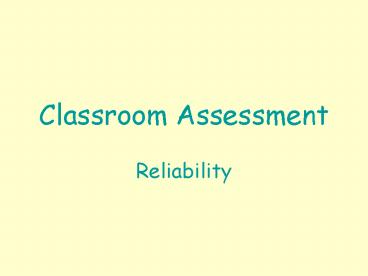Classroom Assessment - PowerPoint PPT Presentation
1 / 19
Title:
Classroom Assessment
Description:
Consistency within teachers over multiple occasions for students. ... except used with non-binary scored (polytomous) items (e.g., items that measure attitude. ... – PowerPoint PPT presentation
Number of Views:14
Avg rating:3.0/5.0
Title: Classroom Assessment
1
Classroom Assessment
- Reliability
2
Classroom Assessment Reliability
- Reliability Assessment Consistency.
- Consistency within teachers across students.
- Consistency within teachers over multiple
occasions for students. - Consistency across teachers for the same
students. - Consistency across teachers across students.
3
Three Types of Reliability
- Stability reliability.
- Alternate form reliability.
- Internal consistency reliability.
4
Stability Reliability
- Stability Reliability
- Concerned with the question
- Are assessment results consistent over time (over
occasions). - Think of some examples where stability
reliability might be important. - Why might test results NOT be consistent over
time?
5
Evaluating Stability Reliability
- Test-Retest Reliability.
- Compute the correlation between a first and later
administration of the same test. - Classification-consistency.
- Compute the percentage of consistent student
classifications over time. (Example on next
slide). - Main concern is with the stability of the
assessment over time.
6
Example of Classification Consistency
Test-Retest Reliability Classification Table Test-Retest Reliability Classification Table Test-Retest Reliability Classification Table Test-Retest Reliability Classification Table
2nd Administration of Test 2nd Administration of Test 2nd Administration of Test
1st Admin. Upper 3ed Middle 3ed Lower 3ed
Upper 3ed
Middle 3ed
Lower 3ed
7
Example of Classification Consistency (Good
Reliability)
Test-Retest Reliability Classification Table Test-Retest Reliability Classification Table Test-Retest Reliability Classification Table Test-Retest Reliability Classification Table
2nd Administration of Test 2nd Administration of Test 2nd Administration of Test
1st Admin. Upper 3ed Middle 3ed Lower 3ed
Upper 3ed 35 5 2
Middle 3ed 4 32 6
Lower 3ed 1 3 38
8
Example of Classification Consistency (Poor
Reliability)
Test-Retest Reliability Classification Table Test-Retest Reliability Classification Table Test-Retest Reliability Classification Table Test-Retest Reliability Classification Table
2nd Administration of Test 2nd Administration of Test 2nd Administration of Test
1st Admin. Upper 3ed Middle 3ed Lower 3ed
Upper 3ed 13 15 4
Middle 3ed 10 24 8
Lower 3ed 11 10 18
9
Alternate-form Reliability
- Are two, supposedly equivalent, forms of an
assessment in fact actually equivalent? - The two forms do not have to yield identical
scores. - The correlation between two or more forms of the
assessment should be reasonably substantial.
10
Evaluating Alternate-form Reliability
- Administer two forms of the assessment to the
same individuals and correlate the results. - Determine the extent to which the same students
are classified the same way by the two forms. - Alternate-form reliability is established by
evidence, not by proclamation.
11
Example of Using a Classification Table to Assess
Alternate-Form Reliability
Alternate-Form Reliability Classification Table Alternate-Form Reliability Classification Table Alternate-Form Reliability Classification Table Alternate-Form Reliability Classification Table
Good Reliability Form B Form B Form B
Form A Upper 3ed Middle 3ed Lower 3ed
Upper 3ed 6 2 1
Middle 3ed 1 7 2
Lower 3ed 0 3 7
12
Example of Using a Classification Table to Assess
Alternate-Form Reliability
Alternate-Form Reliability Classification Table Alternate-Form Reliability Classification Table Alternate-Form Reliability Classification Table Alternate-Form Reliability Classification Table
Poor Reliability Form B Form B Form B
Form A Upper 3ed Middle 3ed Lower 3ed
Upper 3ed 3 2 4
Middle 3ed 2 4 3
Lower 3ed 2 3 5
13
Internal Consistency Reliability
- Concerned with the extent to which the items (or
components) of an assessment function
consistently. - To what extent do the items in an assessment
measure a single attribute? - For example, consider a math problem-solving
test. To what extent does reading comprehension
play a role? What is being measured?
14
Evaluating Internal Consistency Reliability
- Split-Half Correlations.
- Kuder-Richardson Formua (KR20).
- Used with binary-scored (dichotomous) items.
- Average of all possible split-half correlations.
- Cronbachs Coefficient Alpha.
- Similar to KR20, except used with non-binary
scored (polytomous) items (e.g., items that
measure attitude.
15
ReliabilityComponents of an Observation
- O T E
- Observation True Status Error.
16
Standard Error of Measurement
- Provides an index of the reliability of an
individuals score. - The standard deviation of the theoretical
distribution of errors (i.e. the Es). - The more reliable a test, the smaller the SEM.
17
Sources of Error in Measurement
- Individual characteristics
- Anxiety
- Motivation
- Health
- Fatigue
- Understanding (of task)
- Bad hair day
- External characteristics
- Directions
- Environmental disturbances
- Scoring errors
- Observer differences/biases
- Sampling of items
18
Things to Do toImprove Reliability
- Use more items or tasks.
- Use items or tasks that differentiate among
students. - Use items or tasks that measure within a single
content domain. - Keep scoring objective.
- Eliminate (or reduce) extraneous influences
- Use shorter assessments more frequently.
19
- End































